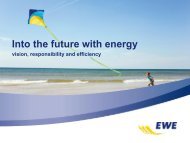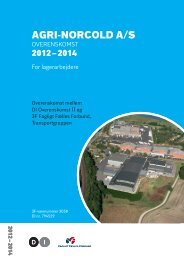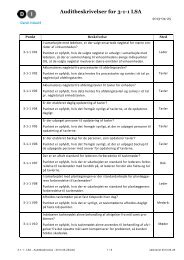Hydrogen and its competitors, 2004
Hydrogen and its competitors, 2004
Hydrogen and its competitors, 2004
You also want an ePaper? Increase the reach of your titles
YUMPU automatically turns print PDFs into web optimized ePapers that Google loves.
30Risø Energy Report 3Technologies for producing hydrogen5.1Conventional water electrolysisConventional water electrolysis uses an alkaline aqueouselectrolyte. The cathode <strong>and</strong> anode areas are separatedby a microporous diaphragm to prevent mixing of theproduct gases. At output pressures of 2-5 bar the processcan reach efficiencies of around 65%. Instead of the alkalineelectrolyte with an inert diaphragm, a solid acidproton conductor of the Nafion type (as used in PEMFCs)can also be used as a combined electrolyte <strong>and</strong>diaphragm [18].Electrolysers are commercially available in capacities of 1kW e -125 MW e . The Electrolyser Corporation Ltd.(Canada), Norsk Hydro Electrolysers AS (Norway) <strong>and</strong>DeNora (Italy) are well-established manufacturers ofelectrolysers for hydrogen, though much of their businessis in the chlor-alkali market. Electrolyser manufacturerswith a more specialized background in hydrogeninclude Ammonia Casale <strong>and</strong> Stuart Energy.High-pressure electrolysisAs the volumetric energy density of gaseous hydrogen israther low, it is an advantage to produce pressurisedhydrogen directly. High-pressure water electrolysers nowbeing developed can generate hydrogen at pressures upto 120 bar from an alkaline electrolyte. A 5 kW e prototypewas tested at Forschungszentrum Jülich in Germany[19]. Another advantage of the high-pressure electrolyseris that <strong>its</strong> internal electrical resistance is lower, so theoverall energy efficiency increases.High-temperature electrolysisHigh-temperature electrolysers started as an interestingalternative during the 1980s. If part of the energyrequired to split the water molecules is supplied in theform of high-temperature heat, less electricity is needed.High temperatures also speed up the reaction kinetics,decreasing the internal resistance of the cell <strong>and</strong>increasing the energy efficiency.High-temperature solid oxide electrolyser cells (SOECs)have the advantage that they can also split CO 2 into CO<strong>and</strong> O 2 . A mixture of steam <strong>and</strong> CO 2 can be electrolysedto give a mixture of H 2 <strong>and</strong> CO – synthesis gas – fromwhich hydrogen carriers such as methane (CH 4 ) <strong>and</strong>methanol (CH 3 OH) may be easily produced. Note thatsuch artificial CH 4 will be a CO 2 neutral hydrogen carrier[20,21].The original idea was to use heat from solar concentratorsor waste heat from power stations for high-temperatureelectrolysis [22]. Low energy prices halted this workaround 1990, but the current emphasis on hydrogen hasbrought renewed interest. If fossil fuels become scarce,high-temperature electrolysis may have a future as a wayto use heat from renewable or nuclear energy sources.Several R&D projects on SOECs are in progress in Europe<strong>and</strong> the USA.Research needsA massive R&D effort is necessary in order to obtain inexpensiveelectrolysers with high durability <strong>and</strong> efficiency.Mainly the following research areas are important in thiscontext: 1) Materials research in order to identifyimproved materials <strong>and</strong> fabricate effective structures, 2)Surface science in order to underst<strong>and</strong> the nature of theinterfaces between the electrodes <strong>and</strong> electrolyte, <strong>and</strong> 3)Solid state electrochemistry in order to underst<strong>and</strong> theprocesses <strong>and</strong> the losses involved. It is of major importancethat these areas are researched in a close interplay.Conclusions <strong>and</strong> recommendationsAt present hydrogen from fossil fuels are by far cheaperthan hydrogen from other sources. A massive researcheffort in the technologies of harvesting the renewableenergy as well as in the conversion technologies is necessaryin order to decrease the cost of "renewable"hydrogen. Synthetic CO 2 neutral hydrocarbons have thepotential of being <strong>competitors</strong> to "renewable" hydrogen,<strong>and</strong> therefore this option should also be carefully consideredthrough serious research programmes.
















